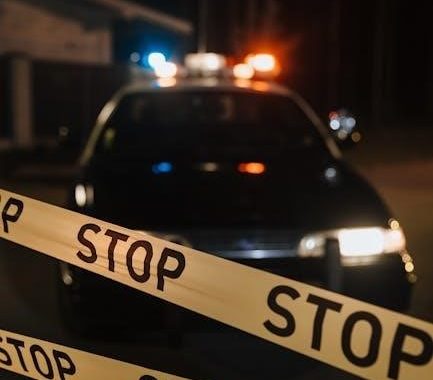stop the bleed pdf

stop the bleed pdf
The Stop the Bleed initiative, launched by the White House, aims to empower bystanders with life-saving bleeding control skills. It addresses the critical need for immediate action in emergencies, providing resources like the Stop the Bleed PDF to guide effective response and save lives.
1.1 Background and Objectives
The Stop the Bleed initiative was launched in response to the 2011 National Preparedness Policy, emphasizing the need for immediate bleeding control in emergencies. Its primary objective is to empower bystanders with essential skills to save lives before professional help arrives. The program focuses on standardized training methods, promoting public awareness, and ensuring accessibility of resources like the Stop the Bleed PDF, which serves as a comprehensive guide for understanding and applying bleeding control techniques effectively in critical situations.
1.2 Importance of Bystander Intervention in Bleeding Emergencies
Bystander intervention is critical in bleeding emergencies, as immediate action can prevent fatal outcomes. The Stop the Bleed initiative emphasizes that uncontrolled bleeding is the leading cause of preventable death after injury. Empowering individuals to act confidently in such situations significantly increases survival rates. By teaching techniques like applying pressure, packing wounds, and using tourniquets, the program enables bystanders to provide life-saving care before professional help arrives. The Stop the Bleed PDF serves as a vital resource, guiding individuals on how to respond effectively in critical moments.

Core Concepts of Stop the Bleed Training
The initiative focuses on the ABCs of bleeding control: Alert, Bleeding, and Compression. These principles guide immediate actions to control severe bleeding effectively, as detailed in the Stop the Bleed PDF.
2;1 The ABCs of Bleeding Control (Alert, Bleeding, Compression)
The ABCs of bleeding control are fundamental to the Stop the Bleed initiative. They stand for Alert, Bleeding, and Compression. First, one must alert others and call 911. Next, identify the source of severe bleeding. Finally, apply compression using hands or a tourniquet to stop blood loss. These steps, outlined in the Stop the Bleed PDF, ensure quick and effective action in emergencies, significantly improving survival chances by preventing excessive blood loss.
2.2 Proper Techniques for Applying Pressure and Packing Wounds
Proper techniques involve applying direct pressure to stop bleeding. Use clean hands or bandages to press firmly on the wound. If bleeding persists, pack the wound with sterile dressings or clean cloth to absorb blood; The Stop the Bleed PDF emphasizes the importance of maintaining firm, steady pressure to minimize blood loss. This method is crucial for controlling hemorrhage until professional medical help arrives, ensuring the best chance of survival in critical situations.
2.3 Use of Tourniquets and Hemostatic Agents
Tourniquets are critical for controlling severe bleeding from limbs. They should be applied tightly between the wound and the heart. Hemostatic agents, like dressings, help blood clot faster. The Stop the Bleed PDF guides proper use of these tools. Tourniquets are a last resort, while hemostatic agents complement direct pressure. Both methods are taught in training to enhance bystander response, ensuring effective bleeding control until medical help arrives. These techniques are vital for saving lives in emergencies.
Resources and Materials for Stop the Bleed Training
The Stop the Bleed PDF provides detailed guides for bleeding control techniques. Additional resources include posters, flowcharts, and training kits, ensuring accessible education for effective emergency response.
3.1 Overview of the Stop the Bleed PDF and Its Contents
The Stop the Bleed PDF serves as a comprehensive guide for bleeding control. It outlines the ABCs of bleeding control: Alert, Bleeding, and Compression. The document includes step-by-step instructions for applying pressure, packing wounds, and using tourniquets. Additionally, it covers the proper use of hemostatic agents and provides visual aids for better understanding. The PDF emphasizes the importance of immediate action and empowers bystanders to act confidently in emergency situations. It is a vital resource for both training and quick reference, ensuring effective response to life-threatening bleeding incidents.
3.2 Availability of Posters, Flowcharts, and Training Kits
Posters, flowcharts, and training kits are essential resources for the Stop the Bleed initiative. These materials provide visual and practical guides for bleeding control techniques. The Save a Life Flowchart and Stop the Bleed Poster are widely available for download, offering clear step-by-step instructions. Training kits include simulated wounds and tourniquets for hands-on practice. These resources are distributed in public spaces, schools, and workplaces, ensuring accessibility. Grants and organizations often cover costs, making them affordable for communities. Their widespread availability helps empower individuals to act effectively in bleeding emergencies, saving lives nationwide.

The Role of Bystanders in Bleeding Control
Empowering bystanders to act in emergencies, the initiative equips individuals with life-saving skills, significantly improving survival rates in bleeding incidents through immediate, effective intervention.
4.1 Empowering Individuals to Act in Emergency Situations
The Stop the Bleed initiative emphasizes empowering individuals to act decisively in emergencies. By providing accessible training and resources, such as the Stop the Bleed PDF, bystanders gain the confidence and skills to control severe bleeding. This empowerment not only saves lives but also fosters a community of prepared individuals capable of immediate, effective response. The program underscores that timely intervention by trained bystanders can significantly improve survival rates and outcomes in critical situations.
4.2 Public Access to Bleeding Control Kits in Gathering Spaces
Public access to bleeding control kits is a cornerstone of the Stop the Bleed initiative. These kits are strategically placed in high-traffic areas, such as schools, malls, and public venues, ensuring immediate availability during emergencies. Many kits are stored in AED cabinets with visible decals, making them easily identifiable. Each kit typically contains essential supplies like tourniquets, hemostatic dressings, and pressure bandages. Cities like Chicago have embraced this initiative, equipping public spaces to empower bystanders and save lives. The Stop the Bleed PDF provides detailed guidance on kit contents and proper usage.

Impact and Success Stories of the Stop the Bleed Campaign
The Stop the Bleed campaign has gained national recognition, training nearly 4 million individuals. Real-life scenarios, such as mass shootings, highlight its lifesaving impact, empowering bystanders to act effectively.
5.1 National Recognition and Adoption of the Program
The Stop the Bleed initiative has garnered widespread national recognition, with the White House and medical organizations endorsing its lifesaving mission. Launched in response to the 2011 National Preparedness Policy, it has trained nearly 4 million individuals, empowering bystanders to act in emergencies. The program’s adoption spans schools, public spaces, and workplaces, with resources like the Stop the Bleed PDF and bleeding control kits becoming essential tools. Its success has led to integration into broader emergency response efforts, solidifying its role in public health and safety.
5.2 Real-Life Scenarios Where Stop the Bleed Saved Lives
Empirical evidence highlights the lifesaving impact of the Stop the Bleed initiative in real-world emergencies. In incidents like the Pittsburgh synagogue shooting and the Boston Marathon bombing, bystanders trained in bleeding control applied tourniquets and pressure, preventing fatal outcomes. These instances demonstrate how immediate intervention can drastically improve survival rates. The program’s emphasis on equipping individuals with practical skills has proven critical in high-stakes situations, underscoring its vital role in public safety and emergency response.

Future Directions and Expansion of the Initiative
The initiative aims to expand its reach by increasing accessibility to training and integrating with other emergency response programs, ensuring more people can act decisively in bleeding emergencies.
6.1 Increasing Awareness and Accessibility of Training
The initiative focuses on expanding its outreach through public campaigns and partnerships, ensuring that Stop the Bleed training is widely accessible. By distributing materials like the Stop the Bleed PDF, the program aims to educate more individuals, particularly in schools and public spaces. Efforts include collaborating with community organizations and leveraging digital platforms to promote the importance of bleeding control. This strategy ensures that life-saving skills reach a broader audience, empowering people to act confidently in emergencies and reducing preventable deaths from bleeding injuries.
6.2 Integration with Other Emergency Response Programs
Efforts are underway to integrate Stop the Bleed training with existing emergency response systems, enhancing a coordinated approach to public safety. By aligning with programs like CPR and AED training, the initiative ensures a comprehensive response to emergencies. The Stop the Bleed PDF serves as a key resource, providing standardized guidelines for bleeding control. This integration aims to create a seamless network of preparedness, ensuring that communities are equipped to handle various crises effectively, ultimately saving more lives through a unified emergency response strategy.
The Stop the Bleed initiative has proven vital in saving lives by empowering individuals with essential bleeding control skills. The Stop the Bleed PDF remains a cornerstone resource, ensuring widespread access to critical information and fostering a culture of preparedness and immediate action in emergencies.
7.1 The Critical Role of Stop the Bleed in Saving Lives
The Stop the Bleed initiative has revolutionized emergency response by equipping bystanders with life-saving skills. Through its comprehensive resources, including the Stop the Bleed PDF, it empowers individuals to act decisively in bleeding emergencies. By teaching the ABCs of bleeding control—Alert, Bleeding, Compression—it bridges the gap between injury and professional help. Real-life success stories highlight its impact, demonstrating how immediate intervention can prevent fatalities. This program has become a cornerstone of public health, fostering a culture of preparedness and saving countless lives in critical moments.